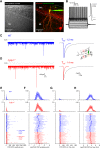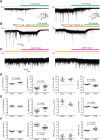Cyfip1 Haploinsufficiency Does Not Alter GABAA Receptor δ-Subunit Expression and Tonic Inhibition in Dentate Gyrus PV+ Interneurons and Granule Cells
- PMID: 31209152
- PMCID: PMC6635810
- DOI: 10.1523/ENEURO.0364-18.2019
Cyfip1 Haploinsufficiency Does Not Alter GABAA Receptor δ-Subunit Expression and Tonic Inhibition in Dentate Gyrus PV+ Interneurons and Granule Cells
Abstract
Copy number variation (CNV) at chromosomal region 15q11.2 is linked to increased risk of neurodevelopmental disorders including autism and schizophrenia. A significant gene at this locus is cytoplasmic fragile X mental retardation protein (FMRP) interacting protein 1 (CYFIP1). CYFIP1 protein interacts with FMRP, whose monogenic absence causes fragile X syndrome (FXS). Fmrp knock-out has been shown to reduce tonic GABAergic inhibition by interacting with the δ-subunit of the GABAA receptor (GABAAR). Using in situ hybridization (ISH), qPCR, Western blotting techniques, and patch clamp electrophysiology in brain slices from a Cyfip1 haploinsufficient mouse, we examined δ-subunit mediated tonic inhibition in the dentate gyrus (DG). In wild-type (WT) mice, DG granule cells (DGGCs) responded to the δ-subunit-selective agonist THIP with significantly increased tonic currents. In heterozygous mice, no significant difference was observed in THIP-evoked currents in DGGCs. Phasic GABAergic inhibition in DGGC was also unaltered with no difference in properties of spontaneous IPSCs (sIPSCs). Additionally, we demonstrate that DG granule cell layer (GCL) parvalbumin-positive interneurons (PV+-INs) have functional δ-subunit-mediated tonic GABAergic currents which, unlike DGGC, are also modulated by the α1-selective drug zolpidem. Similar to DGGC, both IPSCs and THIP-evoked currents in PV+-INs were not different between Cyfip1 heterozygous and WT mice. Supporting our electrophysiological data, we found no significant change in hippocampal δ-subunit mRNA expression or protein level and no change in α1/α4-subunit mRNA expression. Thus, Cyfip1 haploinsufficiency, mimicking human 15q11.2 microdeletion syndrome, does not alter hippocampal phasic or tonic GABAergic inhibition, substantially differing from the Fmrp knock-out mouse model.
Keywords: CYFIP1; GABA; dentate gyrus; neurodevelopmental; tonic inhibition.
Copyright © 2019 Trent et al.
Figures






Similar articles
-
FMRP and CYFIP1 at the Synapse and Their Role in Psychiatric Vulnerability.Complex Psychiatry. 2020 Oct;6(1-2):5-19. doi: 10.1159/000506858. Epub 2020 Mar 3. Complex Psychiatry. 2020. PMID: 34883502 Free PMC article. Review.
-
The parvalbumin-positive interneurons in the mouse dentate gyrus express GABAA receptor subunits α1, β2, and δ along their extrasynaptic cell membrane.Neuroscience. 2013 Dec 19;254:80-96. doi: 10.1016/j.neuroscience.2013.09.019. Epub 2013 Sep 17. Neuroscience. 2013. PMID: 24055402
-
Decreased surface expression of the δ subunit of the GABAA receptor contributes to reduced tonic inhibition in dentate granule cells in a mouse model of fragile X syndrome.Exp Neurol. 2017 Nov;297:168-178. doi: 10.1016/j.expneurol.2017.08.008. Epub 2017 Aug 16. Exp Neurol. 2017. PMID: 28822839 Free PMC article.
-
The expression of GABAA beta subunit isoforms in synaptic and extrasynaptic receptor populations of mouse dentate gyrus granule cells.J Physiol. 2008 Feb 15;586(4):989-1004. doi: 10.1113/jphysiol.2007.146746. Epub 2007 Dec 13. J Physiol. 2008. PMID: 18079158 Free PMC article.
-
Plasticity of GABAA receptors relevant to neurosteroid actions.In: Noebels JL, Avoli M, Rogawski MA, Olsen RW, Delgado-Escueta AV, editors. Jasper's Basic Mechanisms of the Epilepsies [Internet]. 4th edition. Bethesda (MD): National Center for Biotechnology Information (US); 2012. In: Noebels JL, Avoli M, Rogawski MA, Olsen RW, Delgado-Escueta AV, editors. Jasper's Basic Mechanisms of the Epilepsies [Internet]. 4th edition. Bethesda (MD): National Center for Biotechnology Information (US); 2012. PMID: 22787589 Free Books & Documents. Review.
Cited by
-
The transcription factor ZEB1 regulates stem cell self-renewal and cell fate in the adult hippocampus.Cell Rep. 2021 Aug 24;36(8):109588. doi: 10.1016/j.celrep.2021.109588. Cell Rep. 2021. PMID: 34433050 Free PMC article.
-
Generation of Astrocyte-specific BEST1 Conditional Knockout Mouse with Reduced Tonic GABA Inhibition in the Brain.Exp Neurobiol. 2024 Aug 31;33(4):180-192. doi: 10.5607/en24019. Exp Neurobiol. 2024. PMID: 39266474 Free PMC article.
-
FMRP and CYFIP1 at the Synapse and Their Role in Psychiatric Vulnerability.Complex Psychiatry. 2020 Oct;6(1-2):5-19. doi: 10.1159/000506858. Epub 2020 Mar 3. Complex Psychiatry. 2020. PMID: 34883502 Free PMC article. Review.
References
Publication types
MeSH terms
Substances
Grants and funding
LinkOut - more resources
Full Text Sources
Molecular Biology Databases
Research Materials
